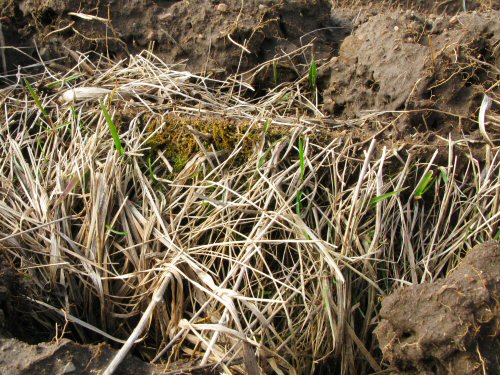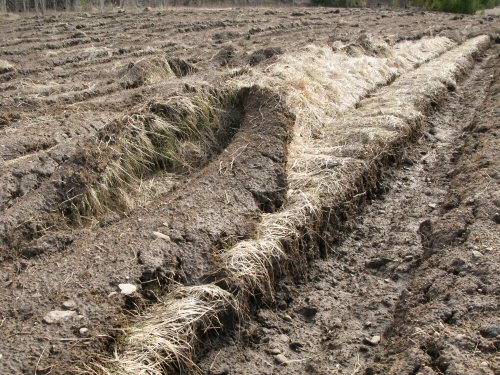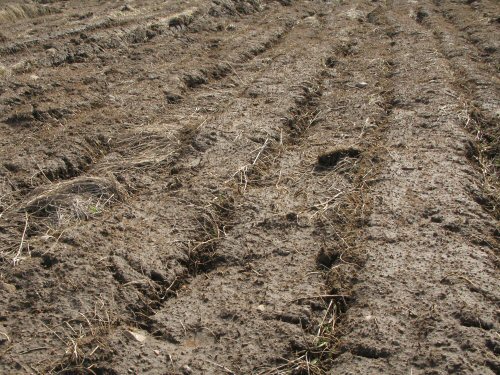
The hay fields were plowed late November, the sod sliced and flipped over by the moldboard, burying the grass so it gets no sun and exposing the severed roots to winterkill. A quick, bold, chemical-free first step in preparing a large clearing for crops. In the couple of garden sections I’ve started like this, it’s been quite effective, but given the slightest break, the grass is ready to come back…

Moldboard plowing—peeling back the land—is usually big-tractor work these days. It takes a lot of energy. If you happen to of soil as a complex living web, an intricately choreographed dance of life taking place mainly in the top 6″ (15cm) or so—sounds good to me!—one look tells you that moldboarding is pretty intense and destructive. Done excessively, with big, modern machines, it is a proven soil killer, encouraging erosion and other unhelpful things. For the tiny farm, this is a one-time-only deal, to start off a new garden area. It’s just the beginning…




Mike,
Are you going to disc this with the kabota or rototill?
hey, i am really enjoing this blog, i hae you all as one of my links. got an rss feed?
Don’t worry too much about the tilling thing—consider what millions of prairie dogs and buffalo used to do to the prairie soils a couple millenia ago…but yah, less is better.
Too much tilling really destroys soil structure. Less tilling is better…even though Troybuilt doesn’t agree…….
Paul: Both. The plowing is custom work, by a friendly organic grain and beef farmer down the road. I was just talking to him this morning about when he could come by to disk. And then I’ll finish with the 48″ rototiller on the Kubota, incorporating that imported compost section by section. That’s the plan. Depending on the timing and weather, I’ll also probably have to do a few beds with just the rototiller, to get started.
Jaqueline: Cool! :)
Steve: Yeah, I don’t worry about over-tilling. I used to be more concerned, just in principle, but some first-hand experience with plowing and rototilling, gave me a more laid-back perspective. I can see how really intensive tillage with huge, heavy machines, year after year, would cause big problems. Or rototilling on any scale to a fine seed bed. But I don’t do either, just a bit of incorporation where needed. I think the planet is cool with that! :)
I’m with you: you do the deep digging to prepare the soil once, but then you leave it alone. That’s what I’m trying to do in my garden, as well.
–Kate
Sounds like you have a good perspective on tilling, Mike. By the way, I really enjoyed a classic book by Ed Faulkner, titled Plowman’s Folly, wherein he took on the agric establishment by arguing that continuous plowing created a plowpan that harmed crop production. The book had quite an impact back when it was published in 1943. Anyway, that’s the philosophy I try to follow in my 2500-sq. ft. backyard garden, to disturb the soil as little as possible after the initial tilling.
Would you consider using a chisel plough to loosen things up again in the future? I dont think it creates the disturbance of the mold board plough.
On a smaller scale, Ive just double dug some garden beds and hope i wont have to repeat for few years
Dennis: I think I’ve heard of that book. I’ll add it to my (really long) reading-or-at-least-having-on-hand-to-read-when-I-get-a-chance list! Thanks!
People concerned with the, uh, Environment and industrial farming should read about hardpan from repeated moldboard plowing and/or repeated heavy machine traffic. It’s not the most sensational subject, but it can really mess up farmland, forming a hard soil layer that doesn’t allow water to drain or even roots to penetrate. I think this is a well-known issue these days (possibly in good part because of that book!). I’m not sure how the big ag practices that lead to it are currently being handled.
NZNeil: Chisel plowing and other types of subsoil plowing that doesn’t turn over the earth sounds good! You need a big tractor, of course, I think it’s around 15-20HP per chisel for deeper plowing. For here, we’d either have to hire in or get a bigger tractor.
At the old farm, the last year or so, I started looking around for someone who did custom work with a chisel plow. The thing is, for small acreage, if you don’t have someone just down the road, it can get expensive to hire in, the cost of getting the gear there can be relatively high.
And, small-job scheduling with a custom work operator can be hard. Even when you’re paying the getting-there charge, they tend to take the big jobs and try to fit you in between, bigger is more efficient for them, and that’s their priority clients. Since it’s all pretty weather-dependent work, you can sometimes get bumped by weeks! I had that happen with a backhoe operator when we were digging a pond, and last fall, we almost didn’t get the fields moldboarded because the regular custom guys had their tractors out getting field corn that was delayed by weather… But that’s a whole separate topic, getting a bit of big machine work done on a tiny farm!
Maybe a local tiny farm coop big tractor service would be a good idea… Small jobs only. Chisel plow, spader, highhoe, spreader, dump truck,… That’d be really cool! Maybe tiny farms could subscribe, get in the queue for a region, and the gear could travel on an efficient route, from plot to plot. Anything from maybe 1-10 acres… Dunno if the numbers would make sense, but it sounds great!!!
(Man, I must be distracting myself from something, every reply here on the blog seems to go on and on lately… :)